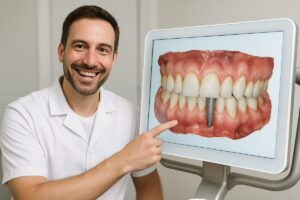Exploring Different Materials in Dental Implants
If you’re considering dental implants, understanding the materials used in the implant process can help you make informed decisions about your oral health, and ensures your implants are compatible with your lifestyle and overall health. Here’s a brief guide to the different implant materials that may be recommended by Dr. Mike after he has performed a thorough assessment of your oral health needs.
Titanium has long been the standard material for dental implants. Valued for its exceptional strength, durability and biocompatibility (the ability of a material to coexist with biological systems, with minimal adverse reactions), titanium implants have a proven track record of success. The properties of titanium encourage osseointegration, the fusion of the implant with the jawbone, which ensures stability and longevity.
Titanium may be standard, but some dental professionals may use titanium alloys in implant construction. These alloys combine titanium with other metals to enhance specific properties, such as increased strength and corrosion resistance. The result is a material that maintains the benefits of titanium while addressing certain limitations.
Zirconia implants have gained popularity for their tooth-like color and exceptional biocompatibility. These implants offer an alternative for those who want a more aesthetically pleasing option. Zirconia’s natural appearance and biocompatibility make it a good choice, particularly for the clearly visible areas in the smile.
Ceramic implants, often composed of materials like alumina or yttria-stabilized zirconia, provide a metal-free alternative. These materials offer excellent biocompatibility, making them suitable for patients with metal sensitivities. Ceramic implants are gaining popularity for their potential to provide long-term stability and aesthetics.
The interaction between implant materials and the human body is critical for your implant’s success. All dental implant materials discussed here prioritize biocompatibility. Understanding how these materials influence tissue response, inflammatory reactions and the process of osseointegration is crucial for informed decision-making. Your care team will work with you to ensure whichever material you choose is biocompatible with your unique needs.
Beyond the choice of material, surface modifications and coatings can play a role in implant success. These modifications and coatings can improve osseointegration by optimizing the implant’s surface properties. Common surface modifications include sandblasting, acid etching, and the application of various coatings. Sandblasting creates a roughened surface to increase implant surface area and improve mechanical retention. Acid etching introduces micro-irregularities on the implant surface, enhancing its bioactive properties. Additionally, coatings can be applied to stimulate bone growth and improve the implant’s integration with surrounding tissues. These advancements in surface technology contribute to the overall success and long-term stability of dental implants.
Dental implantology continues to evolve, exploring new materials and technologies. As you consider dental implants, exploring the different materials available is a key step. Dr. Mike and your Cleveland Implant Institute care team will help you understand how these materials align with your specific needs, so you can enjoy the long-term benefits of dental implants for decades to come.
Mentor Office
6303 Center St
Mentor, OH 44060-2467
Concord Office
8245 Auburn Road
Concord, OH 44077






